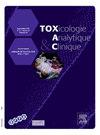Analysis of oral fluid samples results by LC-MS/MS and comparison with law enforcement screening: A 6-year study
IF 1.8
Q4 TOXICOLOGY
引用次数: 0
Abstract
Aim
Oral fluid samples are gradually replacing blood samples, saving time, space and representing non-invasive collection. The aim of this retrospective study was to determine the substances found in salivary samples analyzed by LC-MS/MS and to compare them with those found in screening tests carried out by law enforcement agencies.
Method
This study focuses on the results of narcotics research on salivary screenings received in our laboratory, over 6 years (2018–2023). The salivary swabs were discharged into Quantisal buffer, placed in ultrasound baths and centrifuged. Internal standards solution was added. The narcotics were then extracted in solid phase. Analyses were performed by LC-MS/MS.
Results
In all, 2888 oral fluid samples were analyzed, with an increase of oral fluid analyses files since 2021 (16.8% increase).
Over time, requests for narcotics testing had become more targeted, focusing solely on the class of narcotics that were tested positive. In 2018, the majority of requests were for all narcotics (59% of the total number of samples), compared with 25% in 2023. In contrast, the specific demand for cannabis has risen from 35% in 2018 to 66% in 2023.
By far the most frequently found substance was THC, detected on average in 92.4% of saliva analyzed per year, either alone or in association with one or more other substances, notably CBD. The number of cases with THC found alone had gradually declined, with a parallel increase in the detection of the THC + CBD combination. CBD detection had increased over the years, since it was found only 55 times in 2021 (14%), whereas it represented 64.9% in 2023. CBD alone was found in only 3 of the 2888 saliva analyzed. These increasing CBD and THC association results may be explained by THC smokers using both THC and CBD, in an attempt to evade the law by claiming that the THC found came from their CBD consumption. Cocaine was found in 10.8% of saliva analyzed, MDMA in 1.3%, codeine in 1.9% and morphine in 0.7%. 6-MAM (0.7%), amphetamine (0.4%), acetylcodeine (0.3%) and heroin (0.3%), pholcodine in only 2 cases, methamphetamine in 5, pseudoephedrine in 3 and MDEA in 1 case were also found. Although not requested, ketamine was detected in 5 cases, always associated with cocaine.
For the majority of cases, the LC-MS/MS results correlated with the screenings, but 8,9% (259 of 2888) were false positives (positive screening and absence of the substance in LC-MS/MS), and of these, 2,2% of results were totally negative, probably reflecting false positives linked to the oral fluid screening device or transcription errors. Among these, the most significant were false positives for amphetamines (81% false positives among 128 amphetamine screenings), followed by opiates (31 among 52, 59%) and cocaine (46 among 219, 21%). Although rarer, there were false positives for cannabis (18 out of 259 false positives: 9.1%), but only 18 out of 1621 (total number of positive cannabis screenings [1.1%]). There were also some false negatives (20 of 2888), the most frequent being results obtained in LC-MS/MS following a positive amphetamine screen and a requisition for all 4 narcotics. These results show how important it is to ask for all narcotics, so as not to miss any susbtances.
Conclusion
This study showed the value of confirming salivary samples by LC-MS/MS, and highlighted the high preponderance of THC and the THC + CBD combination in the results. Quantitative oral fluid samples collection system could distinguish cannabis smokers from CBD users.
Ketamine was also found, so looking further ahead, the search for NPS, particularly in screen-negative samples, would be a very interesting subject for study.
LC-MS/MS分析口腔液体样本结果并与执法筛查比较:一项为期6年的研究
AimOral液体样本正逐渐取代血液样本,节省时间、空间,是无创采集的代表。本回顾性研究的目的是确定LC-MS/MS分析的唾液样品中发现的物质,并将其与执法机构进行的筛选试验中发现的物质进行比较。方法本研究以本实验室2018-2023年6年间唾液筛查麻醉药品研究结果为重点。将唾液拭子放入Quantisal缓冲液中,置于超声浴中离心。加入内标溶液。然后以固相提取麻醉品。采用LC-MS/MS进行分析。结果共分析口腔液2888份,自2021年以来增加了16.8%的口腔液分析文件。随着时间的推移,麻醉品检测的要求变得更有针对性,只关注检测呈阳性的麻醉品类别。2018年,大多数请求是针对所有麻醉品(占样本总数的59%),而2023年这一比例为25%。相比之下,大麻的具体需求从2018年的35%上升到2023年的66%。到目前为止,最常发现的物质是四氢大麻酚,平均每年在92.4%的唾液中检测到,无论是单独检测还是与一种或多种其他物质结合,尤其是CBD。单独发现四氢大麻酚的病例数逐渐下降,四氢大麻酚+ CBD联合检测的病例数平行增加。CBD的检出率多年来有所增加,因为2021年仅发现55次(14%),而2023年则占64.9%。在分析的2888份唾液中,仅在3份中发现了CBD。这些增加的CBD和THC关联结果可能是由于THC吸烟者同时使用THC和CBD,试图通过声称发现的THC来自他们的CBD消费来逃避法律。在被分析的唾液中,可卡因占10.8%,摇头丸占1.3%,可待因占1.9%,吗啡占0.7%。6-MAM(0.7%)、安非他明(0.4%)、乙酰可待因(0.3%)、海洛因(0.3%)、福尔可定仅2例、甲基苯丙胺5例、伪麻黄碱3例、MDEA 1例。虽然没有要求,但在5例中发现氯胺酮,总是与可卡因有关。对于大多数病例,LC-MS/MS结果与筛查相关,但8.9%(2888例中的259例)为假阳性(筛查阳性,LC-MS/MS中没有该物质),其中2.2%的结果完全阴性,可能反映了与口腔液筛查装置或转录错误相关的假阳性。其中,最显著的是安非他明的假阳性(在128次安非他明筛查中有81%的假阳性),其次是阿片类药物(52次中有31次,59%)和可卡因(219次中有46次,21%)。虽然较少,但大麻也有假阳性(259例假阳性中有18例:9.1%),但在1621例(大麻筛查阳性总数[1.1%])中只有18例。也有一些假阴性(2888例中有20例),最常见的是在苯丙胺筛查呈阳性的LC-MS/MS中获得的结果,并要求对所有4种麻醉品进行检查。这些结果表明,为了不遗漏任何物质,要求所有麻醉剂是多么重要。结论本研究显示了用LC-MS/MS对唾液样本进行确认的价值,并在结果中突出了THC和THC + CBD组合的高优势。定量口腔液体样本采集系统可以区分大麻吸食者和CBD使用者。氯胺酮也被发现了,所以展望未来,寻找NPS,特别是在筛选阴性样本中,将是一个非常有趣的研究课题。
本文章由计算机程序翻译,如有差异,请以英文原文为准。
求助全文
约1分钟内获得全文
求助全文

 求助内容:
求助内容: 应助结果提醒方式:
应助结果提醒方式:


